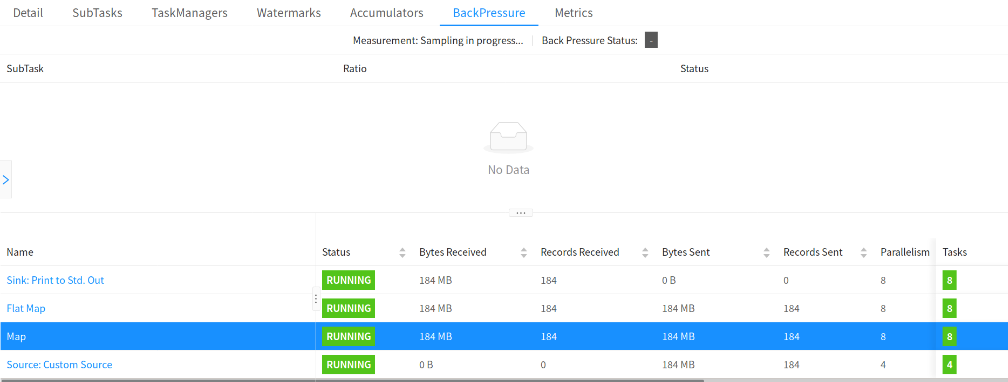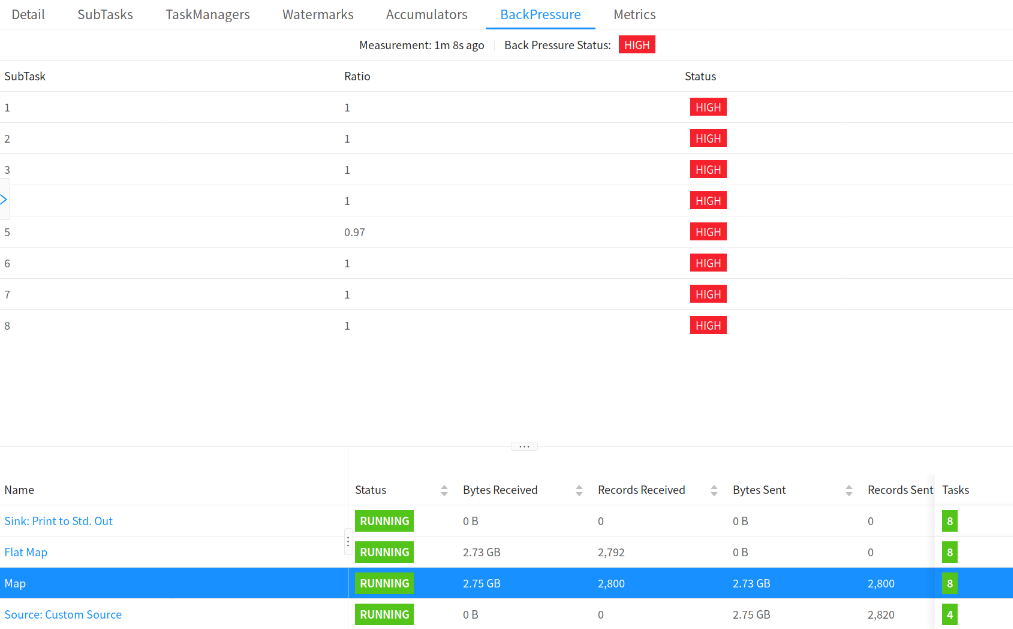Development Suggestions
Consider Increasing the Number of Checkpoints for High Availability
By default, only the latest checkpoint status file is saved. If this file is unavailable (for example, all copies of the HDFS file are damaged), state restoration fails. If we keep two state file checkpoints, Flink rolls back to the state file of the previous one even if the latest checkpoint is unavailable. You can increase the number of reserved checkpoints as needed.
[Example] Set the number of reserved checkpoint files to 2.
state.checkpoints.num-retained: 2
Use Incremental RocksDB as the State Backend in the Production Environment
Flink provides three state backends: MemoryStateBackend, FsStateBackend, and RocksDBStateBackend.
- MemoryStateBackend stores states on the Java heap memory of JobManager. Each state cannot be bigger than an akka frame, and the total size cannot exceed the heap memory size of JobManager. This state backend is suitable for local development and debugging or small-size states.
- FsStateBackend is the file system state backend. Generally, states are stored in the TaskManager heap memory. In checkpointing, states are stored in the file system. The JobManager memory stores only a small amount of metadata (which is stored in ZooKeeper in HA scenarios). Since there is sufficient storage space in the file system, this backend is suitable for stateful processing tasks with large states, long window, or large key value states, and is also suitable for the HA solution.
- RocksDBStateBackend is an embedded database backend. Generally, states are stored in the RocksDB database, and the database data is stored on the local disk. In checkpointing, states are stored in the file system, and the JobManager memory stores a small amount of metadata (which is stored in ZooKeeper in HA scenarios). This state backend is the only one that supports incremental checkpointing. In addition to same scenarios of the FsStateBackend, it is also suitable for processing ultra-large states.
|
Type |
MemoryStateBackend |
FsStateBackend |
RocksDBStateBackend |
|---|---|---|---|
|
Method |
Checkpoint data is directly returned to the master node and is not flushed to disks. |
Data is written to a file whose path is then sent to the master node. |
Data is written to a file whose path is then sent to the master node. |
|
Storage |
Heap memory |
Heap memory |
RocksDB (local disk) |
|
Performance |
Best performance among the three (generally not used) |
High performance |
Poor performance |
|
Disadvantage |
Small data volume only and easy data loss |
OOM |
Time-consuming read/write, serialization, and I/O |
|
Incremental |
Not supported |
Not supported |
Supported |
[Example] Configure a RockDBStateBackend (flink-conf.yaml):
state.backend: rocksdb state.checkpoints.dir: hdfs://namenode:40010/flink/checkpoints
Use EXACTLY ONCE Stream Processing Semantics to Ensure End-to-End Consistency
There are three types of stream processing semantics: EXACTLY ONCE, AT LEAST ONCE, and AT MOST ONCE.
- AT MOST ONCE: The integrity of data cannot be ensured, but the performance is the best.
- AT LEAST ONCE: The integrity of data can be ensured, but the accuracy cannot be ensured. The performance is moderate.
- EXACTLY ONCE: Data processing accuracy can be ensured, but the performance is the worst.
Check whether EXACTLY_ONCE can be ensured. This semantics requires data replay in the source (for example, Kafka message replay) and transactional in the sink (for example, MySQL atomic data writing). If these requirements cannot be met, you can degrade to AT LEAST ONCE or AT MOST ONCE.
- If the source does not support replay, only AT MOST ONCE can be ensured.
- If the sink does not support atomic write, only AT LEAST ONCE can be ensured.
[Example] Use EXACTLY ONCE semantics with API calls:
env.getCheckpointConfig.setCheckpointingMode(CheckpointingMode.EXACTLY_ONCE)
[Example] Set Exactly once semantics in the resource file.
# Semantics of checkpoint execution.checkpointing.mode: EXACTLY_ONCE
Locate Back Pressure Point by Monitoring Information
Flink provides many monitoring metrics for you to analyze the performance states and bottlenecks of a job.
[Example] Configure the number of samples and sampling interval.
# Sampling interval when the valid backpressure result is discarded and backpressed, in ms web.backpressure.refresh-interval: 60000 # Number of backpressure samples web.backpressure.num-samples: 100 # Interval for backpressure sampling, in ms web.backpressure.delay-between-samples: 50
You can view BackPressure in the Overview tab of the job. The following figure shows that sampling is in progress. By default, sampling takes about 5 seconds.

As shown in the following figure, OK indicates that there is no back pressure, and HIGH indicates that a subtask is backpressed.


Switch to the Hive Dialect When Hive SQL Is Used and the Flink Syntax Is Incompatible
Currently, Flink parses SQL syntax with the default or Hive engine. The former supports Flink native SQL, and the latter supports Hive SQL. DDL and DML of some Hive syntax cannot be run using Flink SQL. You can switch to Hive dialect. Pay attention to the following things when using Hive dialect:
- Hive dialect can only be used to operate Hive tables only. Hive dialects should be used with HiveCatalog.
- Although all Hive versions support the same syntax, whether there are specific functions still depends on the Hive version in use. For example, database location update is supported only in Hive-2.7.0 or later.
- Hive and Calcite have different reserved keywords. For example, default is a reserved keyword in Calcite and a non-reserved keyword in Hive. When using Hive dialect, you must use backquotes (`) to reference such keywords so that they can be used as identifiers.
- Views created in Flink cannot be queried in Hive.
[Example] Use Hive syntax to parse SQL statement (sql-submit-defaults.yaml):
configuration: table.sql-dialect: hive
Use Memory Dimension Tables (such as Hudi) for Small- and Medium-scale Data
- In a memory dimension table, dimension data is loaded to the memory. Each TM loads full data and point query joins are performed in the memory. If the data volume is too large, you need to allocate large memory space to the TM. Otherwise, job exceptions may occur.
- In an external dimension table, dimension data is stored in a high-speed K-V database. Point query joins are implemented through remote K-V query. Typical open-source K-V databases include HBase
- State dimension table data is read to streaming jobs in real time as a stream table. Data stream withdrawal is used to ensure data consistency for dimension update and unsynchronized data. Dimension tables are stored for a long time. Currently, Flink on Hudi allows you to set the TTL for a Hudi dimension table.
|
Dimension |
Memory Dimension Table (Hive/Hudi) |
External Dimension Table (HBase) |
State Dimension Table |
|---|---|---|---|
|
Performance |
Very high (within milliseconds) |
Medium (millisecond-level) |
High (within and in milliseconds) |
|
Data volume |
Small, less than 1 GB for a single TM |
Large, in TB level |
Medium, in GB level |
|
Storage |
High memory consumption, full storage of a single TM |
No storage consumption (external storage is used) |
Distributed storage for each TM: memory and disks |
|
Timeliness |
Periodic data loading, low timeliness |
Relatively high |
High |
|
Join result |
Low |
Medium |
- |
Use HBase for Large Dimension Tables
If the data volume is large and data consistency requirement is not high, use HBase KV databases to support point query joins of dimension tables.
Data in the K-V database needs to be written by another job, which has a time difference with the Flink job. The current Flink job may not query the latest data in the K-V database, and the lookup query does not support cancellation. The association result is inconsistent.
Use Stream Tables as Dimension Tables for High Data Consistency
When you are using a Hudi dimension source table, the TTL of the table can be set separately. Data will not age based on the overall TTL of the job. Dimension data can be stored in the state backend for a long time. In addition, stream tables can be used as dimension tables to ensure data consistency with the Flink withdrawal.
Feedback
Was this page helpful?
Provide feedbackThank you very much for your feedback. We will continue working to improve the documentation.See the reply and handling status in My Cloud VOC.
For any further questions, feel free to contact us through the chatbot.
Chatbot





